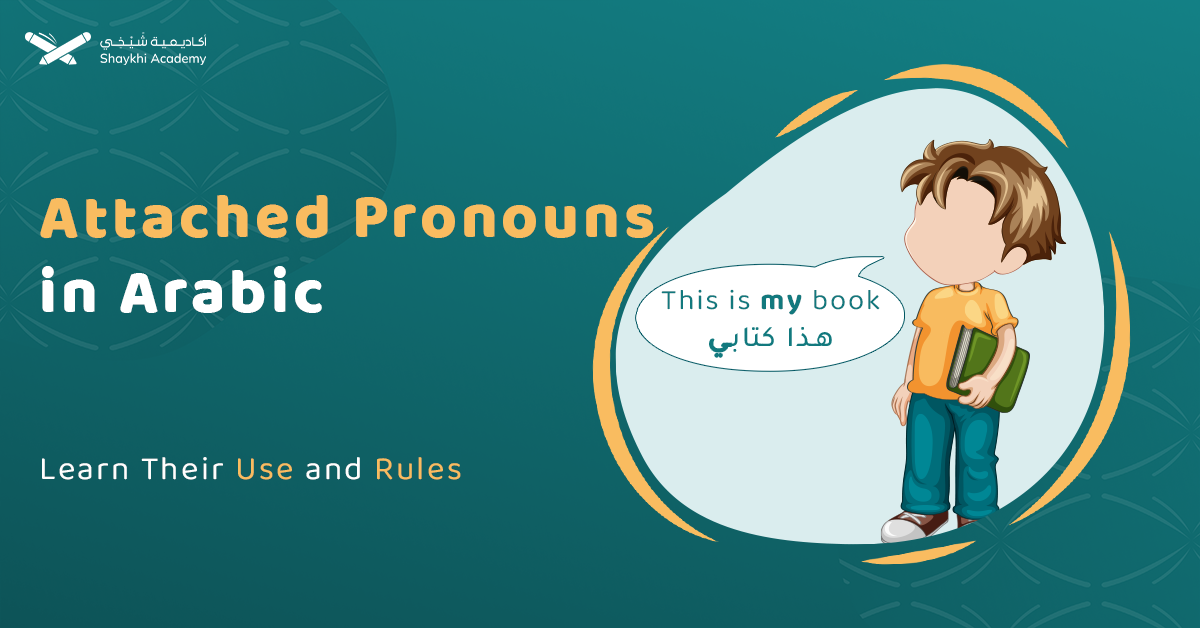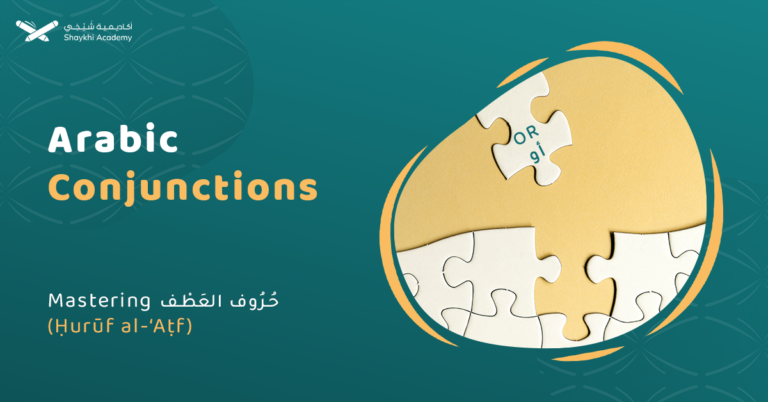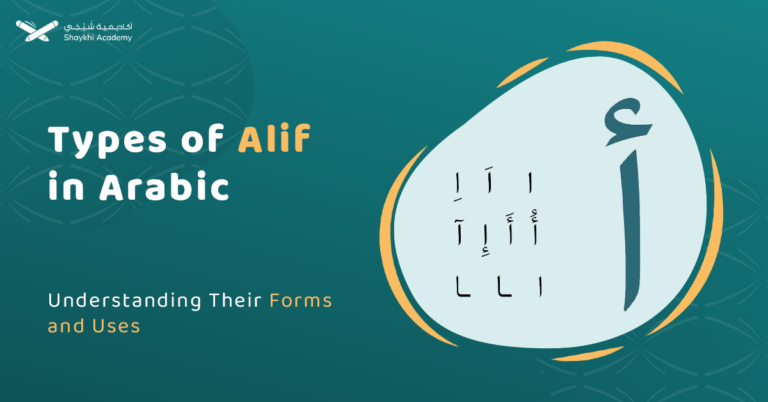Arabic attached pronouns are very unique to the Arabic language. Their function is to simplify, clarify, and beautify the sentence. They can replace the visible noun, which makes communication more concise.
This topic will help you gain a comprehensive understanding of the Arabic attached pronouns, their meaning, usage in Arabic conversation, and characteristics. You will be able to draw the Arabic Attached pronouns chart in your mind.
Arabic Attached Pronouns
Arabic Attached pronouns are known in Arabic as Al Ḍamāʾir al-Muttaṣilah (الضمائر المتصلة). Since they come only attached to the previous word. The previous word must be one of the parts of speech, which are: a noun, a verb, or a particle. According to the type of the previous word, you can determine the grammatical position of the pronoun and its meaning as we will discuss.
Generally,
Types Of The Arabic Attached Pronouns:
The attached pronouns are in 3 categories:
1. Arabic Subjective attached pronouns:
Subjective attached pronouns are found either attached to a verb to explain who did that verb or attached to Kan wa Akhwataha كان وأخواتها. In the second case, they will be Ism kanاسم كان.they are 5 cases
- تاء الفاعل “taa that indicates the doer it has Damma to mean ( I ), Fatha to mean You ”masculine singular” or Kassra to mean you “feminine singular”
For example, the verb read means قرأ
| قرأ | قرأتُ | قرأتِ | قرأتَ |
| The infinitive verb | First person singular | Second person feminine | Second person masculine |
- نا الفاعلين “naa for doers” used for pleural first person.
- واو الجماعة waw indicates pleural third person
- ا ألف الاثنين alif al ethnin that is used for dual
- ي yaa al mokhataba used for the singular feminine second person.
2. Arabic Objective attached pronouns:
Objective-attached pronouns are found either attached to a verb to tell the object or attached to أن وأحواتها which makes the noun in the accusative case. There are 4 main cases:
- ي المتكلم Yaa for the first person
- ك المخاطبة The letter ك indicates the second-person pronoun. it has different suffixes or diacritics according to the number, and gender as follows:
| Singular masculine | Singular Feminine | dual | Pleural feminine | Pleural masculine |
| كَ | كِ | كما | كن | كم |
- هاء الغيبةThe letter” ه” indicates the third-person pronouns. It has different suffixes according to the number, gender
| Singular masculine | Singular Feminine | dual | Pleural feminine | Pleural masculine |
| ه | ها | هما | هن | هم |
- نا المفعولين
This means that the attached pronoun نا can be objective or subjective. You can determine from the context. See these two examples to clarify this.
| example | translation | Type of نا | Explanation |
| رأيتنا | you Saw us | Objective | It refers to the person that is seen. |
| قرأنا | We read | subjective | It refers to person who read |
3. Genitive attached pronouns in Arabic:
When the previous four attached pronouns are attached to a noun or a preposition, they become possessive or genitive pronouns.
See the following example
| The pronoun | Example for objective | Example for genitive |
| هاء الغيبة | كتبه | له |
| نا المفعولين | كلمنا | لنا |
| ك المخاطبة | رأيتكِ | لكِ |
| ي المتكلم | أعطاني | لي |
Arabic Attached pronouns chart
To simplify the categorization of the Arabic attached pronouns, you can draw this chart in your mind to identify them with their meaning and their grammatical case.

All Arabic Attached pronouns meaning
The attached pronouns have many functions. They can express singular, dual, or pleural persons. They also express first-person, second-person, or third-person in the conversation at the same time. This table clarifies their meanings with examples
| Pronoun (Transliteration) | Meaning | Example (Transliteration) |
| Yā’ al-Mutakallim (ياء المتكلم) | First-person singular (masculine and feminine) | كتابي Kitābī (my book) |
| Yā’ al-Mukhāṭabah (ياء المخاطَبة) | Second-person singular (feminine) | كتبتيUktubī (write, feminine) |
| Alif al-Ithnayn (ألف الاثنين) | Dual (masculine) | خرجاKharajā (they (dual) left) |
| Tā’ al-Mutakallim/ al-Mutakallimah (تاء المتكلم/ المتكلمة) | First-person singular (masculine and feminine) | كتبتُKatabtُ (I wrote) |
| Tā’ al-Mukhāṭab (تاء المخاطَب) | Second-person singular (masculine) | كتبتَKatabta (you (masculine) wrote) |
| Tā’ al-Mukhāṭabah (تاء المخاطَبة) | Second-person singular (feminine) | كتبتِKatabti (you (feminine) wrote) |
| Tā’ al-Mukhāṭabayn (تاء المخاطَبَيْن) | Second-person dual (masculine) | كتباKatabtumā (you (dual, masculine) wrote) |
| Tā’ al-Mukhāṭabatayn (تاء المخاطَبَتَين) | Second-person dual (feminine) | كتبتماKatabtumā (you (dual, feminine) wrote) |
| Nā’ al-Mutakallimayn (نا المتكلمَيْنِ) | First-person dual and plural (masculine) | كتابناKitābnā (our book) |
| Hā’ al-Ghā’ib (هاء الغائب) | Third-person singular (masculine) | عنه‘Anhu (about him) |
| Hā’ al-Ghā’ibah (هاء الغائبة) | Third-person singular (feminine) | عنها‘Anhā (about her) |
| Hā’ al-Ghā’ibayn (هاء الغائبَين) | Third-person dual (masculine) | عنهما‘Anhumā (about them (dual, masculine)) |
| Hā’ al-Ghā’ibatayn (هاء الغائبتين) | Third-person dual (feminine) | عنهما‘Anhumā (about them (dual, feminine)) |
| Hā’ al-Ghā’ibīn (هاء الغائِبينَ) | Third-person plural (masculine) | عنهم‘Anhum (about them (masculine plural)) |
| Hā’ al-Ghā’ibāt (هاء الغائِبات) | Third-person plural (feminine) | عنهن‘Anhunna (about them (feminine plural)) |
| Kāf al-Mukhāṭab (كاف المخاطَب) | Second-person singular (masculine) | أخبرتكَAkhbartuka (I told you (masculine)) |
| Kāf al-Mukhāṭabah (كاف المخاطَبة) | Second-person singular (feminine) | أخبرتكِAkhbartuki (I told you (feminine)) |
| Kāf al-Mukhāṭabayn/ al-Mukhāṭabatayn (كاف المخاطَبَيْن/ المخاطَبتَين) | Second-person dual (masculine and feminine) | أخبرتكماAkhbartukumā (I told you (dual)) |
| Kāf al-Mukhāṭabīn (كاف المخاطَبينَ) | Second-person plural (masculine) | أخبرتكمAkhbartukum (I told you (plural, masculine)) |
| Kāf al-Mukhāṭabāt (كاف المخاطَبات) | Second-person plural (feminine) | أخبرتكنAkhbartukunna (I told you (plural, feminine)) |
| Wāw al-Jamā‘ah (واو الجماعة) | Third-person plural (masculine) | عرفوا‘Arifū (they (masculine plural) knew) |
| Nūn al-Niswah (نون النسوة) | Third-person plural (feminine) | عرفن‘Arifna (they (feminine plural) knew) |
You need to read more examples to familiarize yourself with all attached pronouns. You can practice reading with our Arabic reading course.
Characteristics of Arabic Attached Pronouns:
Although there are many types of Arabic Attached pronouns, they all have the following characteristics.
1. They can not serve as a separate word:
Unlike English, not all Arabic pronouns can serve as separate words. In this instance, the Arabic attached pronouns do not come at the start of a sentence or after the particle إلا.
You can learn more details about إلا and other particles in our Arabic grammar course.
2. Arabic Attached pronouns are fixed nouns “asmaa gamdaa”اسماء جامدة :
The main characteristic of the attached Arabic pronouns in all cases is that they are all fixed, unchanging nouns that are attached to the end of a word. They are fixed since they are not derived from another word.
3. Attached pronouns are Mabniyyah nouns:
The Arabic word Mabniyyah in grammar refers to nouns that do not change their diacritics “At-tashkeel” in different grammatical cases.
Exercises For Arabic Attached Pronouns
This grammatical rule is not difficult but you need to practice many times to deepen your understanding and differentiate different types. Here are some exercises.
1. Differentiate the type of the attached Tā’ in the following sentences:
Read the following sentences and identify the type of the attached Tā’ (ت) based on the subject and role in the sentence.
| Sentence | Tā’ Attached To | Type of Tā’ | Explanation |
| استمتعتُ بالقراءة | Verb (استمتعتُ) | First-person singular (I) | The Tā’ refers to the speaker (I). It is attached to the verb for a first-person subject. |
| استمتعتْ سعاد بالقراءة | Verb (استمتعتْ) | Third-person singular feminine (she) | The Tā’ refers to Soad, a third-person singular feminine subject. |
| هل علمتِ بما حدث؟ | Verb (علمتِ) | Second-person singular feminine (you) | The Tā’ refers to a second-person singular feminine subject. |
Notes:
- The letter Tā’ (ت) with a sukoon (ْ) is not a pronoun but a marker for femininity.
- It changes according to the grammatical role (first person, second person, or third person) and gender (masculine or feminine).
2. Differentiate the grammatical position of the first-person plural pronoun “نا” in the following sentences:
Analyze the following sentences and determine the grammatical position of the first-person plural pronoun “نا” (which means “we”).
| Sentence | Pronoun “نا” Position | Grammatical Role | Explanation |
| لقد شاهدْنا الفارس وهو يجري | Verb (شاهدْنا) | Subject | The pronoun “نا” is attached to the verb “شاهدْنا” and acts as the subject, meaning “we saw.” |
| لقد شاهدَنا الفارس ونحن نجري | Subject (نحن) | Object | The pronoun “نا” is attached to the verb “شاهدَنا” and functions as the object of the verb, referring to the action done by “we.” |
Notes:
- In the first sentence, “نا” functions as part of the verb in the past tense, indicating that we performed the action of watching.
- In the second sentence, “نا” is part of the verb again, showing we as the object performing the watching action, and it is connected with the subject “نحن” (we).
3. Extract the attached pronouns and determine their meaning:
For each sentence, identify the attached pronoun and explain its meaning in the context of the sentence.
| Sentence | Attached Pronoun | Meaning of the Pronoun | Explanation |
| رَبَّنَا لا تُؤَاخِذْنَا إِنْ نَسِينَا | نا (attached to رَبَّنَا and تُؤَاخِذْنَا) | Our (referring to “our Lord”) / us (referring to “us”) | The pronoun “نا” in “رَبَّنَا” means “our,” and in “تُؤَاخِذْنَا” means “us” (as the object of the verb). |
| سرتُ ميلًا | تُ (attached to سرت) | I (referring to the speaker) | The pronoun “تُ” indicates that the subject of the verb is “I” (first-person singular). |
| شكر الله لكم حسن استماعكم | كم (attached to استماعكم) | You (referring to the audience) | The pronoun “كم” is used to indicate possession, meaning “your” in this case. |
| السلام عليكم ورحمة الله وبركاته | كم (attached to السلام) | You (referring to the audience) | The pronoun “كم” here means “you” in the context of a greeting. |
| مر أحدهم أمامي | هم (attached to أحدهم) | They (referring to a group of people) | The pronoun “هم” means “they” and refers to the people in the sentence. |
| حررنا بلادنا | نا (attached to حررنا) | We (referring to the speakers) | The pronoun “نا” means “we” and refers to the subject performing the action of freeing the country. |
| تقرأون الدرس | ون (attached to تقرأون) | You (referring to plural, masculine or mixed) | The pronoun “ون” indicates the second-person plural masculine or mixed group, meaning “you.” |
| ذهبن إلى المدرسة | ن (attached to ذهبن) | They (referring to a group of females) | The pronoun “ن” means “they” (feminine plural) and refers to a group of females. |
Notes:
- Attached pronouns in Arabic are closely linked with verbs, nouns, and possessives to indicate subject, object, or possession.
- Pay attention to the context in order to correctly identify the meaning of the pronoun, as it can vary depending on whether it’s referring to a singular, dual, or plural subject.
You can read more Arabic text online and try to extract pronouns. You can find many Exercises online and practice with a group of learners in our Arabic group classes.
Read more about: Detached Pronouns in Arabic الضمائر المنفصلة With Charts, Exercises And Examples
Learn the Arabic language fast with Shaykhyi Academy:
Do you want to speak Arabic in a short time? Join our Intensive Arabic Course Online. Specialists in Shaykhyki Academy choose the best books to provide a comprehensive guide that covers all Arabic language skills, from beginner to advanced levels.
We designed an intensive plan that help you improve all your linguistic skills by studying Arabic basic conversations, grammar, listening, and many more.
Why Shaykhi Academy?
- Expert Native Tutors: Learn from highly qualified native Arabic speakers.
- Flexible Scheduling: Tailor your classes to fit your busy life.
- Affordable Learning: Access top-quality education at a price that suits you.
- Global Access: Study from anywhere in the world.
Explore Our Arabic Courses:
- Noorani Qaida: Build a strong foundation in Quranic Arabic.
- Comprehensive Arabic Courses: Master the Arabic language, from beginner to advanced levels.
- Fusha Arabic Classes: Delve into Modern Standard Arabic, the key to understanding literature, media, and formal communication across the Arab world.
- Quranic Arabic Course: Enhance your connection with the Quran by learning the language in which it was revealed.
Start Your Arabic Journey Today! Whether you’re just starting or looking to deepen your knowledge, Shaykhi Academy is here to support your journey. Book your free trial now and begin your path to Arabic mastery!
Conclusion:
Arabic Attached Pronouns are forming a unique type of pronouns. They are attached to 3 types of speech resulting in 3 grammatical cases: subjective, objective, and genitive. They can take any conversational role including first-person, second-person, and third-person.
They describe the noun number in a smooth flawless method providing precision and beauty to the Arabic language.















































